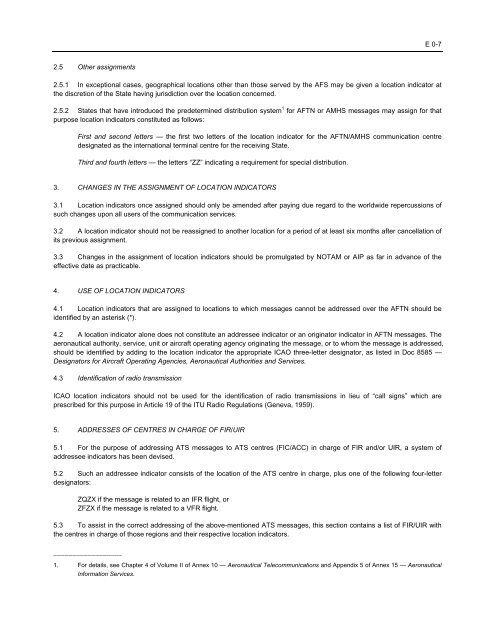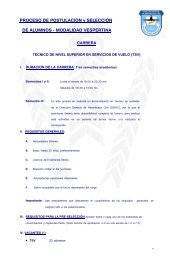LOCATION INDICATORS INDICATEURS D'EMPLACEMENT ...
LOCATION INDICATORS INDICATEURS D'EMPLACEMENT ...
LOCATION INDICATORS INDICATEURS D'EMPLACEMENT ...
Create successful ePaper yourself
Turn your PDF publications into a flip-book with our unique Google optimized e-Paper software.
2.5 Other assignments<br />
2.5.1 In exceptional cases, geographical locations other than those served by the AFS may be given a location indicator at<br />
the discretion of the State having jurisdiction over the location concerned.<br />
2.5.2 States that have introduced the predetermined distribution system 1 for AFTN or AMHS messages may assign for that<br />
purpose location indicators constituted as follows:<br />
First and second letters — the first two letters of the location indicator for the AFTN/AMHS communication centre<br />
designated as the international terminal centre for the receiving State.<br />
Third and fourth letters — the letters “ZZ” indicating a requirement for special distribution.<br />
3. CHANGES IN THE ASSIGNMENT OF <strong>LOCATION</strong> <strong>INDICATORS</strong><br />
3.1 Location indicators once assigned should only be amended after paying due regard to the worldwide repercussions of<br />
such changes upon all users of the communication services.<br />
3.2 A location indicator should not be reassigned to another location for a period of at least six months after cancellation of<br />
its previous assignment.<br />
3.3 Changes in the assignment of location indicators should be promulgated by NOTAM or AIP as far in advance of the<br />
effective date as practicable.<br />
4. USE OF <strong>LOCATION</strong> <strong>INDICATORS</strong><br />
4.1 Location indicators that are assigned to locations to which messages cannot be addressed over the AFTN should be<br />
identified by an asterisk (*).<br />
E 0-7<br />
4.2 A location indicator alone does not constitute an addressee indicator or an originator indicator in AFTN messages. The<br />
aeronautical authority, service, unit or aircraft operating agency originating the message, or to whom the message is addressed,<br />
should be identified by adding to the location indicator the appropriate ICAO three-letter designator, as listed in Doc 8585 —<br />
Designators for Aircraft Operating Agencies, Aeronautical Authorities and Services.<br />
4.3 Identification of radio transmission<br />
ICAO location indicators should not be used for the identification of radio transmissions in lieu of “call signs” which are<br />
prescribed for this purpose in Article 19 of the ITU Radio Regulations (Geneva, 1959).<br />
5. ADDRESSES OF CENTRES IN CHARGE OF FIR/UIR<br />
5.1 For the purpose of addressing ATS messages to ATS centres (FIC/ACC) in charge of FIR and/or UIR, a system of<br />
addressee indicators has been devised.<br />
5.2 Such an addressee indicator consists of the location of the ATS centre in charge, plus one of the following four-letter<br />
designators:<br />
ZQZX if the message is related to an IFR flight, or<br />
ZFZX if the message is related to a VFR flight.<br />
5.3 To assist in the correct addressing of the above-mentioned ATS messages, this section contains a list of FIR/UIR with<br />
the centres in charge of those regions and their respective location indicators.<br />
__________________<br />
1. For details, see Chapter 4 of Volume II of Annex 10 — Aeronautical Telecommunications and Appendix 5 of Annex 15 — Aeronautical<br />
Information Services.





